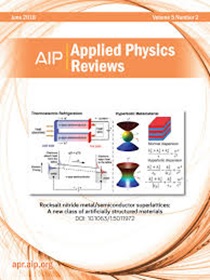Orbital hybridization and magnetic moment enhancement driven by charge density waves in kagome FeGe
IF 11.6
1区 物理与天体物理
Q1 PHYSICS, APPLIED
引用次数: 0
Abstract
Interactions among various electronic states, such as charge density waves (CDWs), magnetism, and superconductivity, are pivotal in strongly correlated systems. While the relationship between CDWs and superconductivity has been extensively studied, the interplay between CDWs and magnetic order remains largely elusive. Kagome lattices, with their intrinsic nontrivial topology, charge order, and magnetism, provide a compelling framework for investigating these interactions. In this work, we unravel the orbital origins of magnetic moment modulation induced by CDW in the kagome magnet FeGe, a system exhibiting a unique coupling between CDW and magnetism. The combination of x-ray absorption spectroscopic experiments and first-principles calculations shed light on the temperature-dependent behavior of Fe3d–Ge4p orbital hybridization and corroborate its significant impact on the magnetic properties of FeGe. These findings introduce an orbital dimension to the correlation between charge and magnetic degrees of freedom, advancing our understanding of the intriguing quantum phases resulting from this interplay.kagome FeGe中电荷密度波驱动的轨道杂化和磁矩增强
各种电子状态之间的相互作用,如电荷密度波(cdw)、磁性和超导性,在强相关系统中是关键的。虽然cdw与超导性之间的关系已被广泛研究,但cdw与磁序之间的相互作用在很大程度上仍然难以捉摸。Kagome晶格具有其固有的非平凡拓扑结构、电荷顺序和磁性,为研究这些相互作用提供了一个引人注目的框架。在这项工作中,我们揭示了CDW在kagome磁铁FeGe中引起的磁矩调制的轨道起源,这是一个表现出CDW和磁性之间独特耦合的系统。结合x射线吸收光谱实验和第一性原理计算,揭示了Fe3d-Ge4p轨道杂化的温度依赖行为,并证实了其对FeGe磁性能的显著影响。这些发现为电荷和磁自由度之间的相关性引入了轨道维度,促进了我们对这种相互作用产生的有趣量子相的理解。
本文章由计算机程序翻译,如有差异,请以英文原文为准。
求助全文
约1分钟内获得全文
求助全文
来源期刊

Applied physics reviews
PHYSICS, APPLIED-
CiteScore
22.50
自引率
2.00%
发文量
113
审稿时长
2 months
期刊介绍:
Applied Physics Reviews (APR) is a journal featuring articles on critical topics in experimental or theoretical research in applied physics and applications of physics to other scientific and engineering branches. The publication includes two main types of articles:
Original Research: These articles report on high-quality, novel research studies that are of significant interest to the applied physics community.
Reviews: Review articles in APR can either be authoritative and comprehensive assessments of established areas of applied physics or short, timely reviews of recent advances in established fields or emerging areas of applied physics.
 求助内容:
求助内容: 应助结果提醒方式:
应助结果提醒方式:


